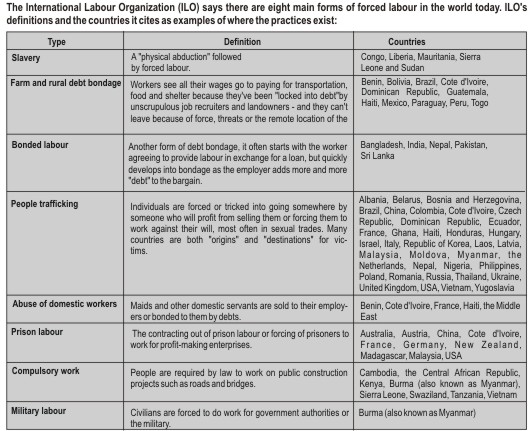For Your Information
What is Slavery?
"No one shall be held in slavery or servitude; slavery and the slave trade shall be prohibited in all their forms" Universal Declaration of Human Rights, Article 4
To be a slave is to be controlled by another person or persons so that your will does not determine your life's course, and rewards for your work and sacrifices are not yours to claim. According to Kevin Bales, one of the world's leading experts on contemporary slavery, "people are enslaved by violence and held against their wills for purposes of exploitation." While people today most likely believe that slavery is a thing of the past, the practice is still thriving wherever poverty, social conditions, and gullability can be exploited. Bale estimates that there are 27 million slaves in the world today. (Kevin Bales, Disposable People: New Slavery in the Global Economy, University of California Press, 1999)
The Slavery Convention (article 1.1) in 1926 defined slavery as
"...the status or condition of a person over whom any or all of the powers attaching to the right of ownership are exercised…."
The convention defined slave trade as
"...all acts involved in the capture, acquisition or disposal of a person with intent to reduce him to slavery; all acts involved in the acquisition of a slave with a view to selling or exchanging him; all acts of disposal by sale or exchange of a slave acquired with a view to being sold or exchanged, and, in general, every act of trade or transport in slaves by whatever means of conveyance." (article 1.2)
The 1926 Convention's definition of slavery was broadened to include forced or compulsory labour in 1930 in the International Labour Organisation Convention (No. 29) concerning Forced or Compulsory Labour (article 2.1):
"...all work or service which is exacted from any person under the menace of any penalty and for which the said person has not offered himself voluntarily."
According to the United Nations, 4 million people a year are traded against their will to work in a form of servitude. The majority of them come from Southeast Asia, Eastern Europe and Latin America.

Slavery includes
1) The practices and institutions of debt bondage: the status or condition arising from a pledge by a debtor of his personal services or of those of a person under his control as security for a debt, if the value of those services as reasonably assessed is not applied towards the liquidation of the debt or the length and nature of those services are not respectively limited and defined.
2) The practices and institutions of serfdom: the condition or status of a tenant who is by law, custom or agreement bound to live and labour on land belonging to another person and to render some determinate service to such other person, whether for reward or not, and is not free to change his status.
3) Servile forms of marriage: a woman, without the right to refuse, is promised or given in marriage on payment of a consideration in money or in kind to her parents, guardian, family or any other person or group; or the husband of a woman, his family, or his clan, has the right to transfer her to another person for value received or otherwise; or a woman on the death of her husband is liable to be inherited by another person.
4) The exploitation of children and adolescents: any institution or practice whereby a child or young person under the age of 18 years, is delivered by either or both of his natural parents or by his guardian to another person, whether for reward or not, with a view to the exploitation of the child or young person or of his labour.
To determine exactly which practices constitute slavery it is necessary to consider the circumstances of the enslavement:
# the degree of restriction of the individual's inherent right to freedom of movement;
# the degree of control of the individual's personal belongings;
# the existence of informed consent and a full understanding of the nature of the relationship between the parties.
Compiled from Human Rights Education Associates.